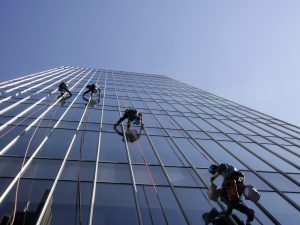Fall protection for aerial lift operators and users, while straightforward in my mind, seems to be a mysterious phenomenon that bewilders the minds of many and produces myths worthy of aNew Yorkbest selling novel! Fortunately, there is no need for it to be this way. Admittedly, the Federal Occupational Safety and Health Administration, OSHA, standards that apply to aerial lifts can be a bit confusing, to say the least. However, once explained, it becomes rather clear as to what is expected of aerial lift users. Besides the standards, a more basic concept can be applied to fall protection for aerial lifts; that concept is, simply put, what’s the best way to keep users from falling? You can’t get much more basic than that. Let’s look at this concept first, and then look at the US OSHA standards to see why they are the way they are.
The American National Standards Institute, ANSI, has a number of classifications for the group of equipment known as aerial lifts. In construction, the four most common types include “Boom Supported Elevating Work Platforms,” “Manually Propelled Elevating Aerial Platforms,” “Self-Propelled Elevating Work Platforms,” and “Mast-Climbing Work Platforms.” On the jobsite, this equipment is also known as boom lifts, scissors lifts, and mast climbers. The significance of all this is that boom lifts respond very differently to the requests of the operator than either the scissors lift or the mast climber. The platform of a boom lift is supported by a single column type strut or beam. This strut can be vertical, horizontal and any angle in between. Scissors lifts, as the name suggests, have interlocking diagonal struts that allow the platform to raise and lower vertically directly above the base support. Mast climbers, as the name suggests, has vertical struts/masts that allow the platform to raise and lower vertically by climbing the mast or masts. The advantage of the boom lift is that the platform can go up and out, and in some cases, up, out, down and under, while the scissors lift platform and mast climber platform primarily only go up and down, similar to an elevator in a building. These varying characteristics dictate the type of fall protection that is required.
The dynamic motion of a boom lift creates the phenomenon not unlike a catapult. The boom can store sufficient energy during movement that it can literally launch the operator up and out of the basket. Scissors lifts and mast climbers don’t develop this type of force and consequently is not normally a concern for fall protection. What all this means is that on scissors lifts and mast climbers we want to keep the worker from walking/falling off the platform while on boom lifts we want the worker not only to be protected from walking off the platform but also from being launched from the platform. This means the first line of protection on all lifts is the guardrail system. For boom lifts it is also necessary to restrain the employee so he/she never leaves the platform. A fall restraint system is required to do this. Therefore, on boom lifts, not only is there a guardrail system to protect the employee but also an anchor to hook the fall restraint system to. Please note that it is a restraint system, not a fall arrest system that is used. We don’t want to have to catch you after you have been launched but rather to keep you from ever launching!
How does this approach to fall protection fit with the applicable regulations, you ask? Well, first and foremost, comply with the manufacturer’s instructions. These machines are sophisticated devices and the manufacturer is the authority on fall protection for his/her specific device. The manufacturer may require more protection than I described above. For example, scissors lifts may require the occupant to utilize personal fall arrest equipment attached to the specified anchor. The manufacturer may require other safety devices that are not required by the OSHA standards. If this is the case, you are expected to comply with those requirements provided they are more restrictive than the OSHA standards. This brings us to the standards.
Aerial lifts are addressed in Subpart L of the Construction Industry Standards, specifically section 29 CFR 1926.453. These standards are exclusive to aerial lifts. (Note that the Scaffold General Requirements, 29 CFR 1926.451, do not apply to aerial lifts, as clarified in the first sentence of that section.) Because OSHA standards cannot reference standards that are not in existence at the time of issuance, 29 CFR 1926.453 references ANSI Standard A92.2-1969 which was the applicable standard in 1986 when the revised scaffold standards were first proposed. This 1969 standard does not reflect the multitude of machines that have been developed since then; unfortunately OSHA is stuck with this limitation. Fortunately, OSHA recognizes this limitation and allows that equipment manufactured and used in compliance with more current standards will be recognized to be in compliance with 29 CFR 1926.453. (See Non-Mandatory Appendix C of the OSHA Scaffold Standards for a list of those standards.) This leads us specifically to Standard 29 CFR 1926.453(b)(2)(v) which requires that “a body belt shall be worn and a lanyard attached to the boom or basket when working from an [extensible or articulating boom platform] aerial lift.” A note follows this regulation pointing out that a belt cannot be used for fall arrest but can be used for tethering. Remember from the discussion above, that if you are properly anchored to the basket of a boom lift, you will never leave the basket and consequently will not be exposed to the forces of a fall. It should be obvious from all this that if you do not anchor yourself properly you will leave the platform or basket and then we will have to catch you. In that case you better be wearing a harness or you will probably kill yourself. Bottom line, use short lanyards when using a boom lift so you never leave the basket.
Guardrail systems are used to keep workers from walking/falling off the platform or out of the basket. Personal fall restraint is required to keep you in a boom lift. Comply with the manufacturer’s recommendations no matter what type of aerial lift you are using; those requirements may be more restrictive than the OSHA minimum standards. And a couple of final thoughts: A 6 foot lanyard used with a restraint belt is a killer, a 6 foot lanyard used in a basket will still allow you to get launched; keep that in mind when you idly hook off so you “look good.” And if you’re the truck driver loading the boom lift on the truck, watch out—you have a better chance than anybody of getting launched.











